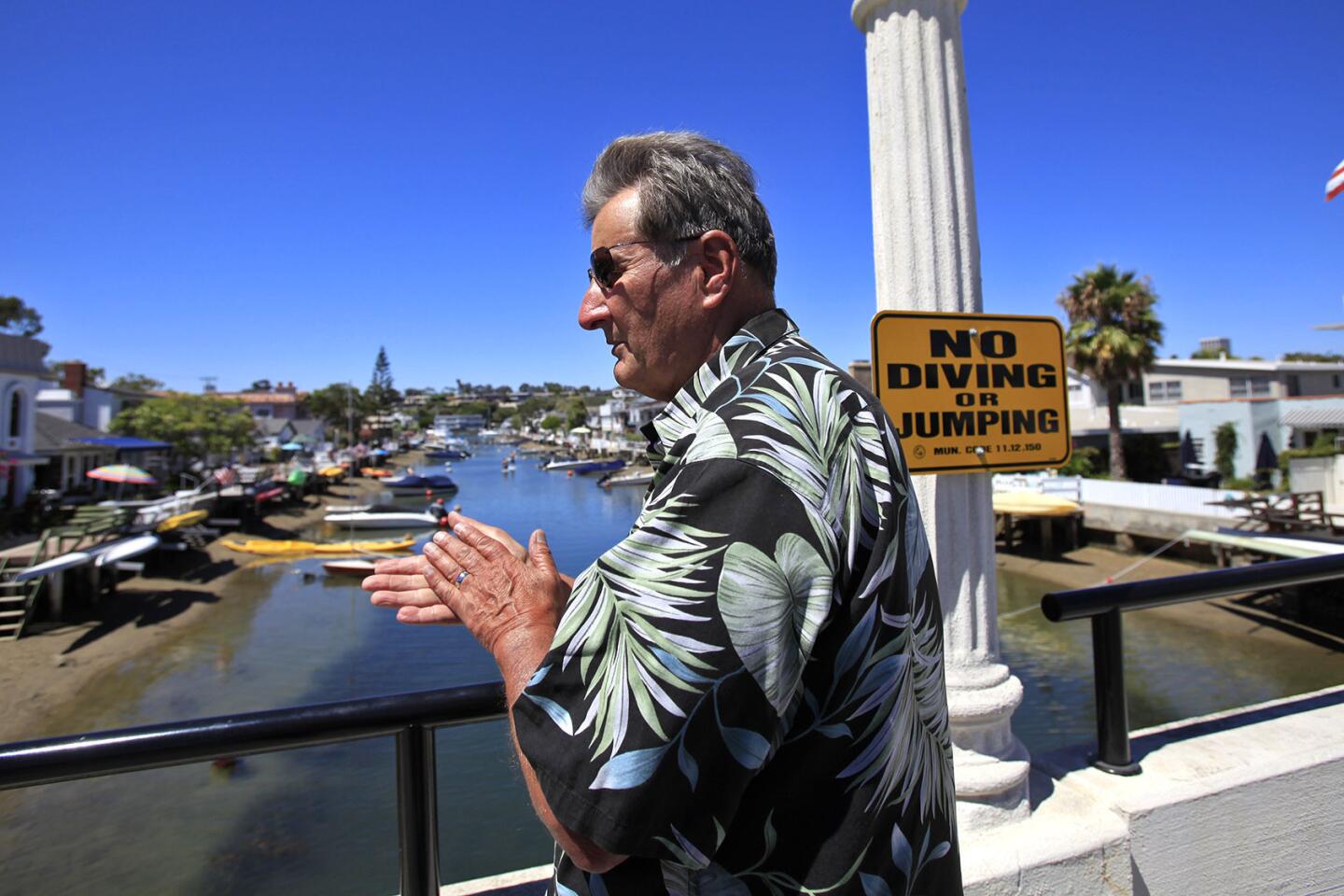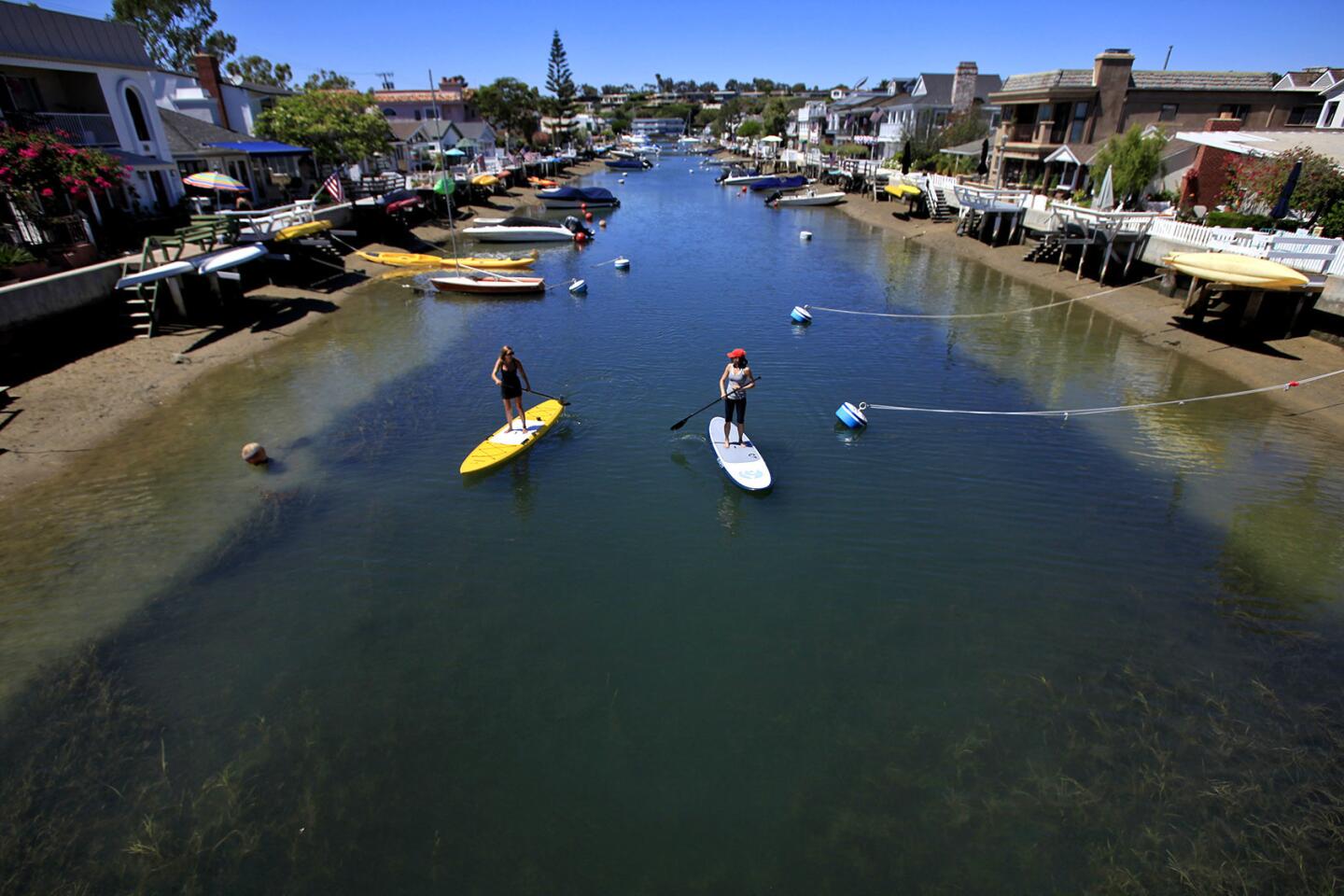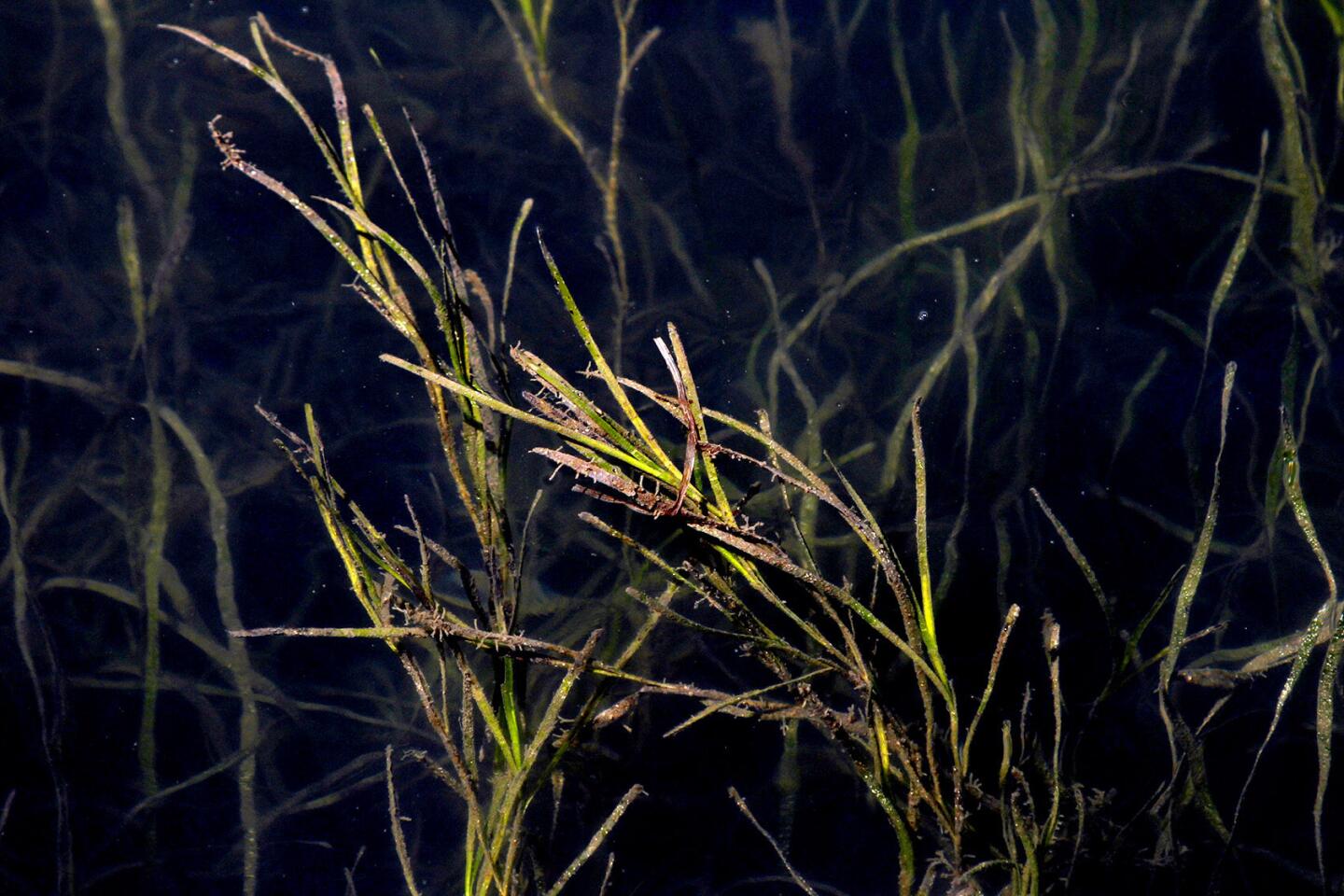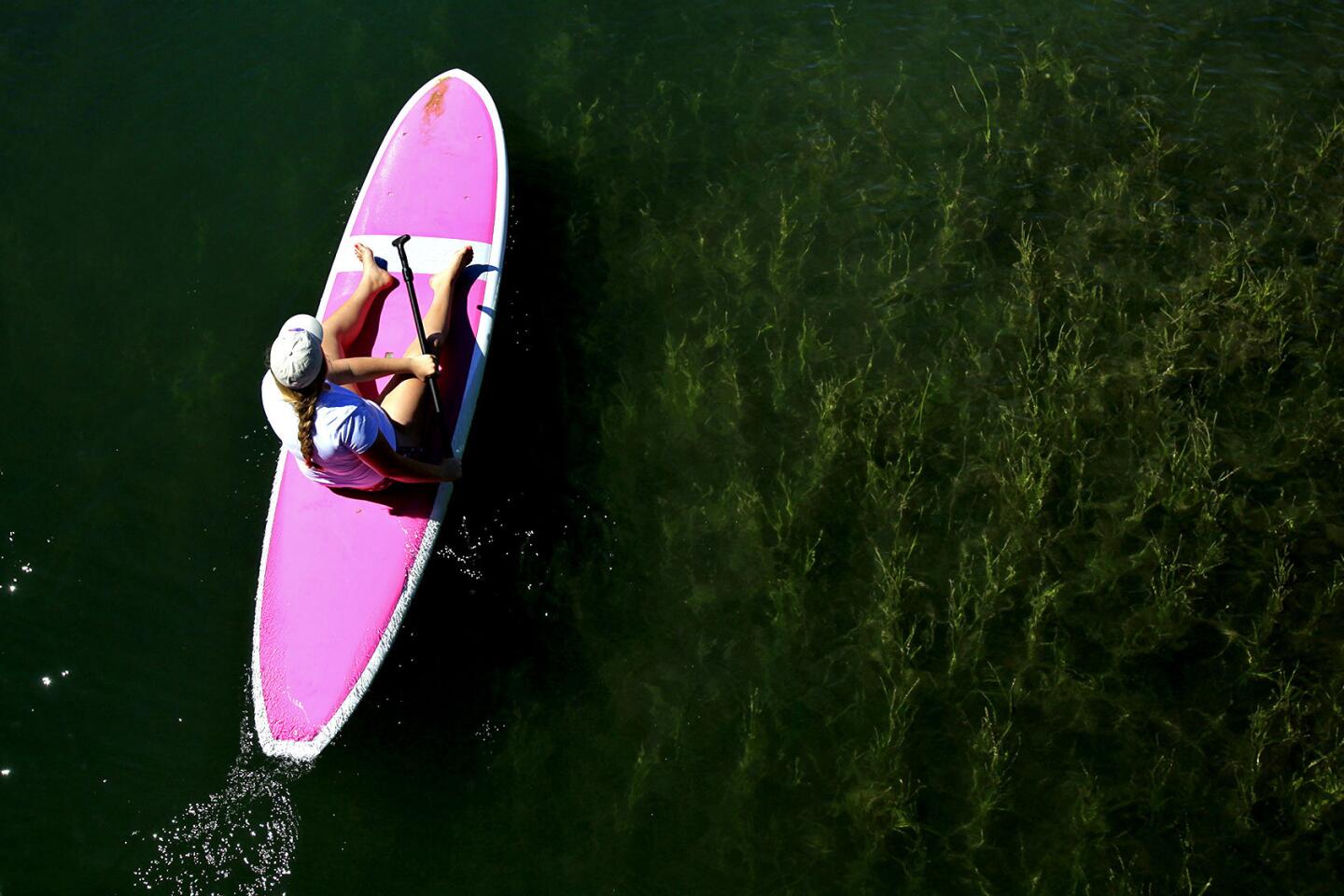Environmental rules make Grand Canal less than grand
Once alive with children playing on the sandy shoreline or leaping headlong into the shimmering water, the Grand Canal is now having trouble living up to its name.
Although Balboa Island still radiates charm with its early day cottages, its rival frozen banana stands and its faithful ferry service, the sand has sloughed away along the watery channel that cuts through it, and sediment has washed in to the point that the canal sometimes resembles a mud flat.
Here, in the shallow waters, long, green tendrils of eelgrass thrive.
“That’s our issue,” said island resident Mike Buettell, standing atop the Park Avenue bridge and pointing to the tangle of shoots swaying in the water.
The emerald tufts of grass, which have blossomed in harbors and waterways along the California coast, are a life-giving environment for fish, crabs, snails and seabirds. But the underwater fields of eelgrass have become an unyielding enemy to those like Buettell.
More than anything, he is convinced, it’s the eelgrass that’s standing in the way of the canal becoming grand again.
::
Buettell’s great-grandfather put down roots on the island in 1937, when he bought a lot for $600 and built a beach cottage.
In those days, the city shoveled out the canal, clearing away the sand — and the eelgrass.
The plant always seemed to grow back, Buettell recalls, and as a child he and his friends raked a pathway through the strands to reach the deeper waters where it didn’t grow. They disliked how the plant felt when it swooshed back and forth against their skin.
Buettell and his wife, Sue, both 67, still live in the family home, but nowadays “it’s as if the city’s forgotten the canal.”
Complicating any effort to dredge the canal are the strict rules protecting eelgrass in Southern California: For every square foot of eelgrass that is disturbed, 1.2 square feet must typically be replanted and maintained for five years.
The mitigation process is expensive, often prohibiting residents from completing simple projects like expanding their docks.
“It’s just almost impossible for an individual like me to get dredging done,” said Seymour Beek, 80, who lives in what he calls “eelgrass heaven” on the south shore of Balboa Island.
Beek said he used to dig out sand from in front of his bayfront home every two or three years. Now more than a decade has passed since he last dredged.
His floating dock settles onto the damp sand during low tide, yet he’s been unable to get a permit that the city has pre-negotiated with various agencies to dig away the sediment that has built up. Instead, if there’s eelgrass within 15 feet of a project site, an applicant must go it alone, pursuing approval from the Army Corps of Engineers, California Coastal Commission and State Water Resources Control Board — which can be a daunting bureaucratic process.
“There’s eelgrass everywhere practically,” Beek said. “It’s all over the place.”
::
Eelgrass has become a dominant plant in bays and estuaries throughout Southern California, its hardiness attributed in part to improved water quality, which allows sunlight to reach farther into its depths.
Rick Ware, a marine biologist and president of the Long Beach-based Coastal Resources Management, conducts marine analysis for those who hope to get a dredging permit, measuring the amount of grass that would be affected, evaluating water quality and taking stock of other marine life such as mussels, sea slugs and crabs.
From this, his firm develops plans to mitigate for the uprooted forests, using what he calls the “anchor-bundle method.” Shoots of the plant are tied with a biodegradable line to a biodegradable “anchor” (usually a tongue depressor), which is plunged 6 or 9 inches below the mud into a grid pattern on the harbor floor.
The tricky part is where to put it.
Ideally, the eelgrass is restored around the mitigation site. But the point of dredging is to make the water deeper, and as a result, eelgrass may not grow.
Some harbors have taken creative approaches. In Long Beach’s Alamitos Bay, an unused portion of a parking lot next to the water was converted to create marine habitat. In the Port of Los Angeles, engineers made an area more shallow in order to coax the eelgrass into growing
But Newport is running out of places to plant the eelgrass, Ware said.
When the Irvine Co. was asked to mitigate 59 square feet of eelgrass lost during the renovation of a marina, it spent more than $500,000 to construct, monitor and maintain a mitigation area where 430 square feet of eelgrass was planted.
Under increasing pressure, Harbor Resources Manager Chris Miller hopes to soon finalize an eelgrass management plan for Newport Harbor.
Still in its conceptual stages, the plan is intended to allow the city to determine how much eelgrass can be uprooted without affecting its overall presence in the harbor.
Whether removing the eelgrass from the Grand Canal — 1.06 acres by the last count — would be permissible under the new plan remains to be seen. But even so, Miller has hired a consultant to begin work on an independent dredging plan for the site. He is also considering putting sand in the canal to help stabilize the seawalls and improve the beach area.
In the meantime, the frustration of residents sometimes flares.
“Visitors and residents alike walk the perimeter of the big and little islands every day, enjoying mostly scenic beauty,” homeowners Nancy and Joe Fries wrote in a letter to Mayor Pro Tem Ed Selich, who represents the area. “But the appearance of the canal is an eyesore. The smell is an affront. For those of us with homes along the canal, it’s an unfair detriment to our property values and our quality of life.”
::
On a recent Tuesday morning, Buettell walked toward the mouth of the canal on the south side of the island. A Balboa Island baseball cap shaded his eyes as the sun broke through the clouds. He took off his shoes, rolled up his pants and stepped down into the muck.
Aesthetics and recreation aside, houses on the island are also at risk, Buettell said. He pointed under the sea wall, where several inches of sand had eroded — hinting at a future threat to the foundation of the homes.
Nearby, three youngsters scampered on a pile of rocks, looking for crabs as mud covered their feet.
Their father, Jeff Gottfurcht, explained that he had explored the area himself as a child. Now a San Francisco resident, he and his family were visiting his parents, who live nearby. While on the island, he wanted to re-create the experiences for them that he once had.
One of his two daughters, Ella, proudly displayed a bucket with three crabs that she had caught within minutes.
“Three, three, three,” she sang.
She bent over and pinched a fourth.




